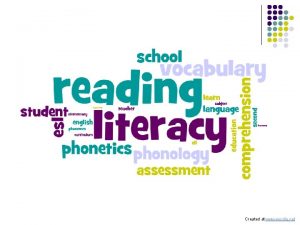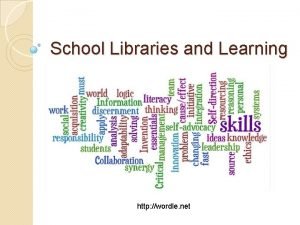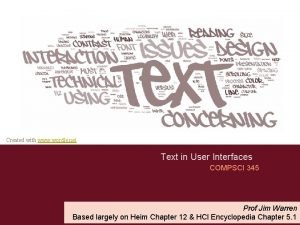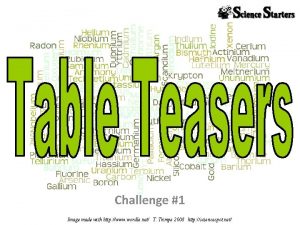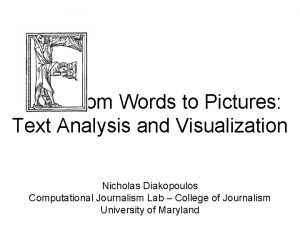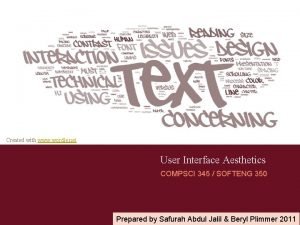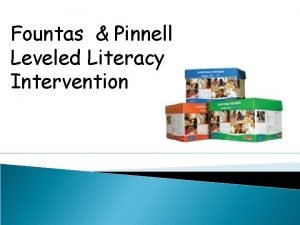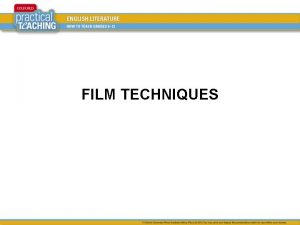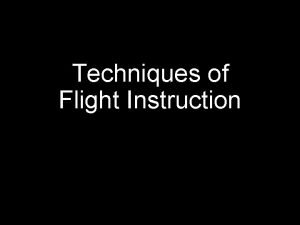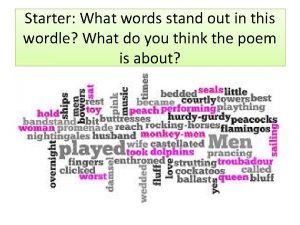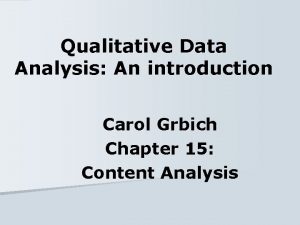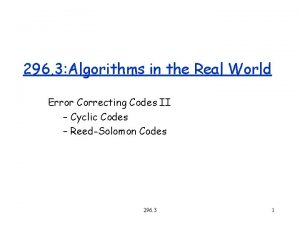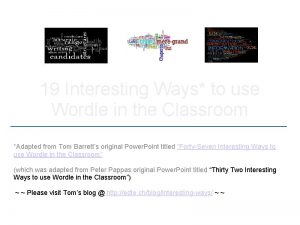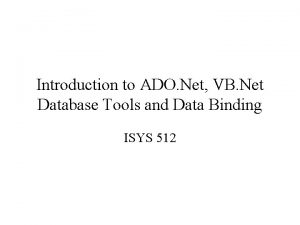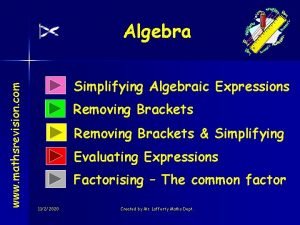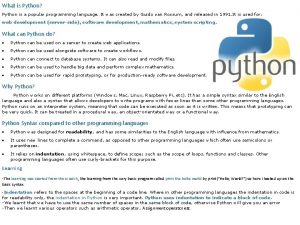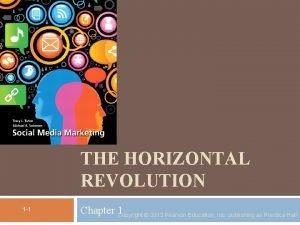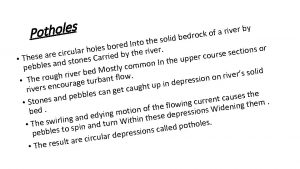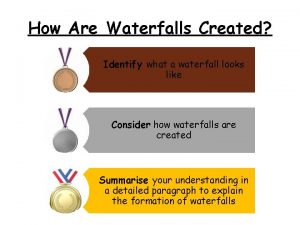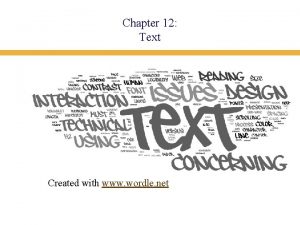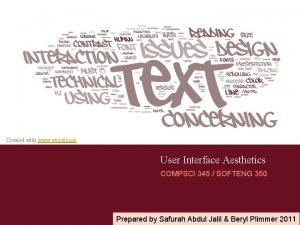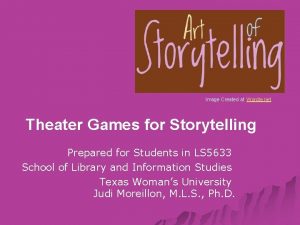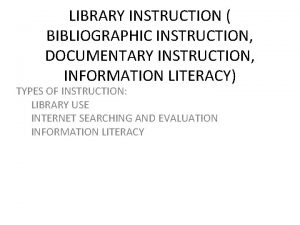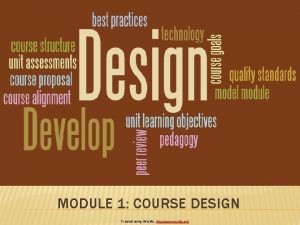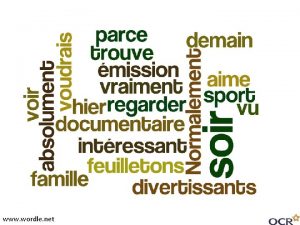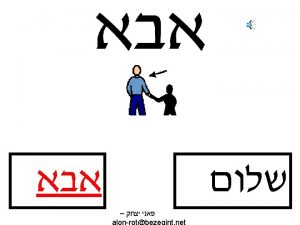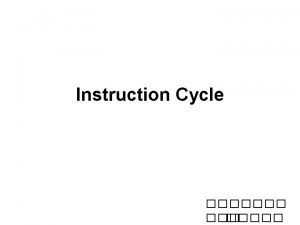Created at www wordle net Literacy Instruction Techniques




































































- Slides: 68

Created at www. wordle. net

Literacy Instruction: Techniques on How to Teach a Beginner Jackie Foster Shari Vass Jolene Helgason November 24 th, 2008 EDPY 413 University of Alberta

Literacy Instruction l l l Key Points About ELLs Phonics and Phonetics Vocabulary Building Comprehension/Assessment Reflection

Created at www. wordle. net

Key Points to Remember about English Language Learners

Key Points to Remember about English Language Learners l Differences between immigrants and refugees. l ELLs need a supportive learning community. l ELLs’ ability to decode does not equal ability to understand (vocabulary & context). l ELLs may lack knowledge of grammatical structure. l Ex. When I went to the park, I …

Key Points to Remember about English Language Learners l Some ELLs need to learn an entirely new orthography and phonology (writing and sound systems). l Some ELLs may never have had formal schooling in their L 1 and as such, they need to learn to read, in addition to learning to read in English.

Key Points to Remember about English Language Learners l Teaching styles vary widely from country to country. l l E. g. making inferences from texts may be a completely new concept. Some ELLs who have formally studied English in their home country, may have a preference for reading and writing or speaking and listening, depending on how they were taught.

Key Points to Remember about English Language Learners l Some ELLs may experience difficulty hearing certain sounds. l E. g. Distinguishing between two sounds. l Some may have a high level of BICS but a low level of CALP. l ELLs competent in reading in their L 1, can use some of the same strategies to read in English.


Phonology & Phonetics What is it? Why is it important to ELLs? How do you teach it?

What is it? (Congdon, 1974, pp. 1 -2) l Phonetics: The science of sounds. l Phoneme: Spoken sound. The smallest unit of sound in a word. l E. g. BATH has three (3) phonemes: /b/ /a/ /th/. l Phonics: The visual representation of speech sounds found in the various letters or clusters of letters in written words. l Grapheme: The written visual representations. l E. g. the letters of the alphabet (the ‘b’ ‘a’ ‘t’ ‘h’).

What Does it Mean to Teach Phonics? Phonics instruction examines the relationships between the letters of written language (graphemes) and the individual sounds of spoken language (phonemes) and how these relationships are used to read and write words (Carnine et al, 2006 p. 55).

Phonemic Awareness (Carnine et al, 2006, p. 35) l Refers to the awareness of phonemes (the smallest units of sound in spoken language). l Focus is on identifying and manipulating individual sounds within words.

The Reading Teachers Book of Lists, Fifth Edition, 2006, by John Wiley & Sons, Inc.

Phonemic Awareness (cont’d) l Carnine et al (2006) identified Phonemic Blending and Phonemic Segmentation as the two most crucial components. l This is because they are directly related to sounding-out words.

Why is having Phonemic Awareness Important? More specifically, why is it important for English Language Learners?

Phonetics & Pronunciation l l l Amy Gregory (2003) taught two applied linguistics courses in Spanish. She was not happy with the pre-service teachers’ level of knowledge in Phonetics and Phonology. The teachers did not see the relevance of it to their future teaching careers.

Phonetics & Pronunciation (Cont’d) l Gregory (2003) notes that “the knowledge of phonetics and phonology can be vital in the acquisition of target [language] pronunciation” (p. 203). l She states that teaching the learner how the sounds of the L 2 are different from the L 1 is a useful method to help the learner perceive the L 2 phonemes.

Phonetics & Pronunciation (Cont’d) l Instructors are likely to be more concerned that their students are communicating meaning rather than proper pronunciation (Gregory, 2003). l On that note, she quoted one of her students saying that: …the professors and peers stop correcting us after they think that we know sufficient enough Spanish to get by. So then you have students who aren’t afraid to speak it in front of a big group and sometimes we really can’t understand them because they are speaking very fast and unclear (p. 203).

How is Proper Pronunciation Relevant to Reading? l Roberts (2005) conducted a study and reported that “quality of English articulation was found to have a robust influence on children’s phonemic awareness and beginning word reading” (p. 610). l Furthermore, she found that English oral proficiency (having basic communicative competence) was not significantly related to phonemic awareness or word reading.

Roberts (2005) (cont’d) l l l Articulation and vocabulary were found to be highly correlated and both were associated with higher levels of phonemic awareness. However, articulation had a much stronger effect. In fact, vocabulary only had an effect through articulation. l Having a larger vocabulary results in better articulation. Better articulation has a strong effect on phonemic awareness.

So what? l We have seen how having better articulation and pronunciation helps ELLs improve their phonemic awareness. l Does this help them read better?

The Development of Reading in Children Who Speak English as a Second Language (Lesaux & Siegel, 2003). l This study examined students’ reading levels in Kindergarten and classified the students as being L 1 or ESL. l From there, they divided each group into “atrisk” for reading failure and “not-at-risk”.

The Development of Reading in Children Who Speak English as a Second Language (Lesaux & Siegel, 2003) Cont’d l All Kindergarten children were then given phonological awareness training in the form of classroom-based small group learning. l l Some carried on into Grade 1. Students were then re-assessed in Grade 2

The Development of Reading in Children Who Speak English as a Second Language (Lesaux & Siegel, 2003) Cont’d l Findings: l l l “It is clear that Kindergarten phonological awareness instruction in the context of a balanced early literacy program is as effective for ESL speakers as it is for L 1 speakers in the early grades of school” (p. 1016). By Grade 2, ESL children were reading at the same level or higher than the L 1 children. “Phonological processing was the single best predictor of Grade 2 word reading ability” (p. 1017).

The Development of Reading in Children Who Speak English as a Second Language (Lesaux & Siegel, 2003, p. 1016)

The Development of Reading in Children Who Speak English as a Second Language (Lesaux & Siegel, 2003) Cont’d l l As with Roberts (2005), this study also found that fluency and proficiency in English were less important in determining reading level than successfully acquiring the soundsymbol relationship of the language. Phonological Awareness ability (or lack thereof) has been linked to difficulties with early reading acquisition in both L 1 and ESL children.

Phonology in Second Language Reading: Not an Optional Extra (Walter, 2008) l Walter’s study compared two ESL groups to an L 1 English group. l The two ESL groups were divided by their L 2 reading comprehension ability into either the “Good C” group, or the “Poor C” group.

Phonology in Second Language Reading: Not an Optional Extra (Walter, 2008) Cont’d l Phonological Similarity Effect: l l l “Good C” L 2 group performed just as well as the L 1 group. The “Poor C” L 2 group, performed significantly worse than both groups. A follow-up study confirmed that the poorer performance by the “Poor C” group was not due to insufficient grapheme correspondences.

How To Teach Phonetics to ESL Students l Walters (2008) concluded that to improve L 2 reading comprehension, it may be necessary to spend time explicitly teaching ELLs to recognize L 2 phonemes. l She recommends games that differentiate minimal pairs.

How To Teach Phonetics to ESL Students Cont’d l Minimal Pairs are sets of words that are exactly the same except for one phoneme. l l E. g. “cat” and “sat”. Only the /c/ and /s/ differ. BINGO!

www. eslhq. com

Elkonin Boxes www. bogglesworldesl. com Each pair has one sound in common. Students listen for the common sound. Then mark it on the Elkonin box. As an optional exercise students can stretch out the words and fill in the boxes with the corresponding graphemes for each phoneme.

Elkonin Boxes www. bogglesworldesl. com

Elkonin Boxes www. bogglesworldesl. com

Teaching Phonemic Awareness l The National Reading Panel identified Rhyming as a phonological awareness skill (as cited in Carnine et al, 2006). l l It focuses students on the parts of words that are bigger than phonemes, but smaller than syllables. Teaching rhyming prepares students to put word parts together.

The Reading Teachers Book of Lists, Fifth Edition, 2006, by John Wiley & Sons, Inc.

Created at www. wordle. net

Vocabulary knowledge is knowledge; the knowledge of a word not only implies a definition, but also implies how that word fits into the world. (Stahl, 2005)

Vocabulary Development l Words are grouped into 3 tiers by Beck and colleagues so that a systematic method of selecting vocabulary to teach to students is possible(Calderon, 2007, pp. 30 – 33) l 1) Tier 1 § l 2) Tier 2 § § § l Words that English-speaking students already know Words that have importance and utility Words that have instructional potential Words for which students already have a conceptual understanding 3) Tier 3 § Words that students are unlikely to know and are not frequently used

Tier 1 (Calderon, 2007, p. 30) l These are words that ELLs need for everyday speech, for academic conversations and for explanations. l l ELLs typically know the concept in their primary language but not the label in English. l l Examples: Connectors: so, if, then, and, the Examples: Basic words: find, answer, tooth Example: A tier 1 word may be “butterfly”; it may be a word that is unfamiliar but can be easily taught in a lesson just by showing a picture.

Tier 2 (Calderon, 2007, p. 32) l l These are words that have importance and utility because they are in grade-level texts. These words are targeted for instruction l l Some research shows that tier 2 words get missed by ESL teachers as they typically teach tier 1 words and mainstream teachers generally teach tier 3 words (content words). These are words in which the students may understand the general concept but would need assistance in describing it.

Tier 2 Word List consult establish accelerate context evaluate achieve contrast evident isolate prime adjacent contribute expand Magnetic principle stable alternative convert expose magnitude proceed statistic analyze create external major publish status approach criterion feasible manipulate pursue structure approximate crucial fluctuate mathematics random subsequent arbitrary data focus method range suffice assert define formulate minimum react sum assess Definite function modify region summary assign demonstrate generate negative require technique assume denote guarantee notion respective technology authorize derive hypothesis obtain restrict tense automatic design identify obvious reverse theory chapter devise ignore occur role trace compensate devote illustrate passive section tradition complex dimension impact period segment transmit complicate distinct implicit perspective select ultimate comply distort imply pertinent sequence undergo component element indicate phase series usage comprehend emphasize individual phenomena shift valid conceive empirical Inhibit portion signify vary concentrate ensure initial portion similar verbal concept entity innovation potential simultaneous verify conclude environment intense precede sophisticated vertical consequent equate interpret precise species consist equivalent intuitive presume specify constant involve construct http: //mercury. educ. kent. edu/database/eureka/documents/introducingnewvocabteacherresourcechart_handout. doc

Tier 3 (Calderon, 2007, p. 33) l l These words are specific to certain content areas, thus they are low-frequency words in English. Students will likely learn these words as they learn a new concept. An example of a tier 3 word, would be photosynthesis. l

Teaching Vocabulary New vocabulary needs to be explicitly taught to get the English language learner caught up to grade level.

Teaching Vocabulary Word Definition Context Connection Prompt region An extensive, continuous part of an area or space. A part of the earth's surface (land or sea) of considerable and usually indefinite extent: a tropical region. What region of the world would you like to visit? http: //mercury. educ. kent. edu/database/eureka/documents/introducingnewvocabteacherresourcechart_handout. doc

Teaching Vocabulary l Teaching new vocabulary before introducing it in a new unit is critical for comprehension! l It is vital to the student that the teacher pre -teach the words that will be in the material. The ELL student may not know any English words in that subject area.

7 Steps To Pre-Teaching Vocabulary (Caleron, 2007, p. 34) 1. 2. 3. 4. 1. 2. Say the new word in English State the word in context from the text Provide a definition Provide an example that clarifies the word’s meaning (use student-friendly language) Have the students repeat the word 3 times Get the students engaged with the word Have the students say the word again (either alone or in the original sentence).

Teaching Vocabulary l Use visuals when introducing new vocabulary l l Create a word wall in the classroom Put labels around the classroom so that students can make connections between oral and written English. Use real objects to encourage students to use all of their senses to learn Use graphic organizers so that students are able to see the relationship between new and existing concepts. l l Venn diagrams are used to compare and contrast words across subjects, which helps them remember that the new word may have multiple meanings. Flow charts and mind maps are also useful.

Teaching Vocabulary l Allow for lots of practice through a variety of activities. l Allow students to make their own dictionaries/ glossaries l Allow for group work l Example: Students could work in pairs and draw pictures to remember the word or make a poem l Read-Alouds l Vocabulary is developed through the ongoing dialogue between the teacher and the students regarding the text that is being read. The teacher will use different types of questions and stop at specific times to initiate a discussion.

Where Do We Go From Here? l Use Frequency Lists – The 2000 highest frequency words in English comprise about 80% of the text l The General Service List of the top 2000 frequent words: l l http: //www. auburn. edu/~nunnath/engl 6240/wlistgen. html http: //www. lextutor. ca Choose Words From Tier 2 – these academic words cross over domains and broaden vocabularies Use Engaging Materials - use visuals, pictures, labels and real objects when ever possible. l Picture dictionaries and bilingual dictionaries may also be very useful.

The Reading Teachers Book of Lists, Fifth Edition, 2006, by John Wiley & Sons, Inc.

Strategies to Teach New Vocabulary (Caleron, 2007, p. 43) l For Reviewing Words With Numbered Heads Together l l Students number off from 1 – 4. The teacher gives them a typed list of Tier 1, 2, and 3 words learned that week. Students must make sure everyone in the team knows the definition, spelling, pronunciation, and how to use that word in a sentence. The teacher calls a number, the corresponding student is given a word and must answer for the team by saying it, spelling it, and using it in a sentence.

Strategies to Teach New Vocabulary l For Reviewing Words with Expert Jigsaw l l l The teacher gives each team a different set of laminated index cards with vocabulary words on one side and definitions on the other. Students must make sure everyone in their team knows the definition, spelling and pronunciation of each word and how to use it in a sentence. Then, every 3 minutes two students go to a different table to teach and test those students.

Strategies to Teach New Vocabulary l For Reviewing Words with Vocabulary Roundtable l l Each team uses only one paper and one pencil. In round-table style, each student writes one word learned that week and passes the paper to the right. The next student writes a different one, and so on, until the teacher calls time. The team with the most words wins.

Created at www. wordle. net

Ideas for Aiding Comprehension

Drucker (2003). What reading teachers should know about ESL learners. The Reading Teacher; Sep 2003; 57, 1; Pro. Quest Education Journals pg. 23

Comprehension Strategies l Previewing l Paired Reading l Choral readings l Books with tapes l Shared Reading l Multicultural literature

Comprehension Strategies (Cont’d) l l l Language experience approach l Narrow reading l Read aloud l Think alouds Interactive writing Total physical response

Comprehension Strategies (Cont’d) l GIST (Generating Interaction between Schemata and Text) l Free Voluntary Reading l Story Re-enactment l Group work

Assessment l Running records l Acting l Paraphrasing l Illustration l Allowing extra time

Assessment l l l Use performance assessments, as they show what the child can do and what they know Graphic organizers Reading inventories Reading conferences Anecdotal notes

Reading Conference Record Houk, F. A. (2005). Supporting English Language Learners: A guide for teachers and administrators. Portsmouth, New Hampshire: Heinemann

Reflection l What caught your attention? l What concerns do you have? l What are the key insights here? l What are you personally committed to do?

References l l l Calderon, M. (2007). Reading to English language learners, Grades 6 -12: A framework for improving achievement in the content areas. California: Corwin Press Carnine, D. W. , Silbert, J. , Kame’enui, E. J. , Tarver, S. G. , Jungohann, K. (2006). Teaching struggling and at-risk readers. Upper Saddle River, NJ: Pearson Education. Cobb, T. (2007). Why & how to use frequency lists to learn words. Retrieved from http: //www. wordhacker. com/en/article/usefrequency 2 learnwords. htm Congdon, P. J. (1974). Phonic skills and their measurement. Oxford: Blackwell Crawford, B. , Cummins, J. , Giles, S. , Grant, K. , Jensen, V. , Mc. Phail, S. , et al. (2002) Literacy place teacher’s toolkit: A guide to using literacy place in your classroom. Markham, Ontario: Scholastic Canada. Davies S. K. , Taylor, D. (2007) Teaching English language learners: Strategies that work. New York: Scholastic. Day, R. R. (Ed. ). (1993) New ways in teaching reading. Alexandria, Virginia: Teachers of English to Speakers of Other Languages Drucker (2003). What reading teachers should know about ESL learners. The Reading Teacher; Sep 2003; 57, 1; Pro. Quest Education Journals pg. 22 Fry, E. B. , & Kress, J. E. (2006). The reading teachers book of lists (5 th ed. ). San Fransico, CA: Jossey-Bass Gregory, A. E. (2005). What’s phonetics got to do with language: Investigating future teachers’ use of knowledge about phonetics and phonology. In N. Bartels (Ed. ), Applied linguistics and language teacher education (vol. 4) (pp. 201 -220). Haynes, J. Vocabulary Instruction for English language learners. Retrieved from http: //www. everythingesl. net/inservices/vocabulary_instructi_language__80932. php Herrell, A. L. , Jordan, M. (2008) 50 strategies for teaching English Language Learners (3 rd ed. ). Upper Saddle River, New Jersey: Pearson Education.

References l l l Houk, F. A. (2005). Supporting English language learners: A guide for teachers and administrators. Portsmouth, New Hampshire: Heinemann Lesaux, N. K. , & Siegel, L. S. (2003). The development of reading in children who speak English as a second language. Developmental Psychology, 39(6), 1005 -1019. doi: 10. 1037/00121649. 39. 6. 1005 Mc. Intyre, E. , Kyle, D. W. , Chen, C. T. , Kraemer, J. , Parr, J. (2009) 6 principles for teaching English language learners in all classrooms. Thousand Oaks, California: Corwin Press. Muchisky, B. (2007) Classroom strategies: A tool kit for teaching English Language Learners. Westport, Connecticut: Teachers Ideas Press. Roberts, T. A. (2005). Articulation accuracy and vocabulary size contributions to phonemic awareness and word reading in English language learners. Journal of Education Psychology, 97(4), 601 -616. doi: 10. 1037/0022 -0663. 97. 4. 601 Rojas, V. P. (2007). Strategies for success with English language learners. Alexandria, Virginia: Association for Supervision and Curriculum Development. Toohey, K. (2007). English language learners and literacy assessment. The Canadian Modern Language Review/La Revue canadienne des langues vivantes, 64(2), 253– 272. Walter, C. (2008). Phonology in second language reading: Not an optional extra. TESOL Quarterly, 42(3), 455 -474. Retrieved from http: //www. ingentaconnect. com West, G. I. (2005). Success with struggling readers: The benchmark school approach. New York: Guilford Press www. wordle. net www. eslhq. com www. bogglesworldesl. com
 Wordle net
Wordle net Http://wordle
Http://wordle Wordle.net
Wordle.net Wordle.net
Wordle.net Wordle title font
Wordle title font Wordle docker image
Wordle docker image Globele wordle
Globele wordle Http://www.wordle.net/create
Http://www.wordle.net/create Wordle double letters
Wordle double letters Similarities of media information and technology literacy
Similarities of media information and technology literacy Memes about media and information literacy
Memes about media and information literacy What do you think are people media
What do you think are people media Cyber literacy and digital literacy
Cyber literacy and digital literacy Leveled literacy instruction
Leveled literacy instruction Individualized instruction vs differentiated instruction
Individualized instruction vs differentiated instruction Indirect instruction definition
Indirect instruction definition Camera shots
Camera shots Techniques of flight instruction
Techniques of flight instruction Fonctions techniques et solutions techniques
Fonctions techniques et solutions techniques Wordle classroom ideas
Wordle classroom ideas Physics wordle
Physics wordle Poetle wordle
Poetle wordle Wordle mandarin
Wordle mandarin Wordle nuage de mots
Wordle nuage de mots Wordle 2-1
Wordle 2-1 Wordle starters
Wordle starters Wordle orge
Wordle orge Wordle 205x
Wordle 205x Www.wordle
Www.wordle Wordle
Wordle Ekg measurements
Ekg measurements Wordle alm
Wordle alm Ronaldo pictures
Ronaldo pictures Wordle of rhe day
Wordle of rhe day Wordle norsk
Wordle norsk Lyrics in my heart there rings a melody
Lyrics in my heart there rings a melody Wordle 204 3/6
Wordle 204 3/6 Wordle 209
Wordle 209 Wordle
Wordle Teamwork wordle
Teamwork wordle Achmed lach net
Achmed lach net Ado.net vb.net
Ado.net vb.net Who created algebra
Who created algebra Global wind belts
Global wind belts What is python
What is python What kind of wave is created if a tree falls in a forest?
What kind of wave is created if a tree falls in a forest? Uluru creation story
Uluru creation story When god created woman poem
When god created woman poem Consequences of the truman doctrine
Consequences of the truman doctrine Horizontal revolution
Horizontal revolution Who created the federal reserve
Who created the federal reserve Generally restful like a horizontal the sky meets land
Generally restful like a horizontal the sky meets land Declaration of independence all men are created equal
Declaration of independence all men are created equal Detective created by author sir arthur conan doyle
Detective created by author sir arthur conan doyle Synovial fluid and sperm
Synovial fluid and sperm A process in sculpture putting additional parts
A process in sculpture putting additional parts How are potholes created
How are potholes created Rank size rule vs primate city
Rank size rule vs primate city Large monuments created from huge stone slabs
Large monuments created from huge stone slabs Types of sound devices
Types of sound devices Zone of situ accretion
Zone of situ accretion Land and sea breezes animation
Land and sea breezes animation What is this part
What is this part How black hole is created
How black hole is created How is a plunge pool formed
How is a plunge pool formed How are stars created
How are stars created Chime framework
Chime framework Francois vatel period it was created and performed
Francois vatel period it was created and performed When was hinduism founded
When was hinduism founded
